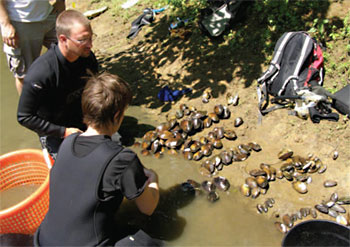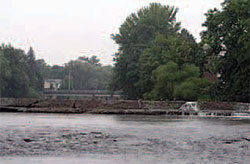The Mussels of Conewango Creek
The Western Pennsylvania Conservancy’s Natural Heritage Program is performing an assessment of freshwater mussels along the 13 miles of Conewango Creek from the New York/Pennsylvania border to where it flows into the Allegheny River at Warren, Pa. This will provide information about the rare Rayed Bean mussel and help determine how a recent dam removal is affecting the mussel populations there.

WPC Watershed Conservation staff members Eric Chapman and Tam Smith identify and count mussels.
This Allegheny River watershed supports globally significant populations of Northern Riffleshell and Clubshell mussels, both listed as endangered, as well as other rare species. WPC hopes to learn whether the Rayed Bean mussel, a candidate for endangered listing, might inhabit Conewango Creek. The stream also positivly affects the water quality of the Allegheny downstream.
Mussels add value to waterways by cleaning the water through their unique water-filtration feeding system. Studies show that mussels can filter all of the water in a river system multiple times per day. As filter feeders they’re also sensitive to water quality and serve as indicators of stream health.
Mussel populations remain healthy in free-flowing streams with good water quality. Obstructions, such as dams, prevent upstream and downstream colonies from connecting as a viable population. These animals adapt to a specific habitat, and cannot survive sudden changes such as depth, temperature, increased silt or decreased flow. The construction of dams has been a major cause of decline.

WPC’s assessments will help determine how mussel populations in Conewango Creek are affected by the environmental stress brought on by a man-made dam.
The 2009 removal of Carter’s Dam by The Fish and Boat Commission is expected to improve mussel habitat and reconnect aquatic communities of Conewango Creek to those of the Allegheny River. The old dam was in disrepair and also breached.
WPC completed an earlier survey of Conewango Creek in 2005, when the dam was still intact. Staff members assessed the mussel community upstream and downstream of the dam and found that there were mussel species of concern present. At that time, they relocated mussels from below the dam to an upstream location to protect them from being smothered in silt from the future dam removal.
This second survey will gather baseline data describing the mussel populations before the long-term effects of the dam’s removal take place. Over time, staff will watch mussel migration, which will be useful to assess the success of mussel relocation efforts.
